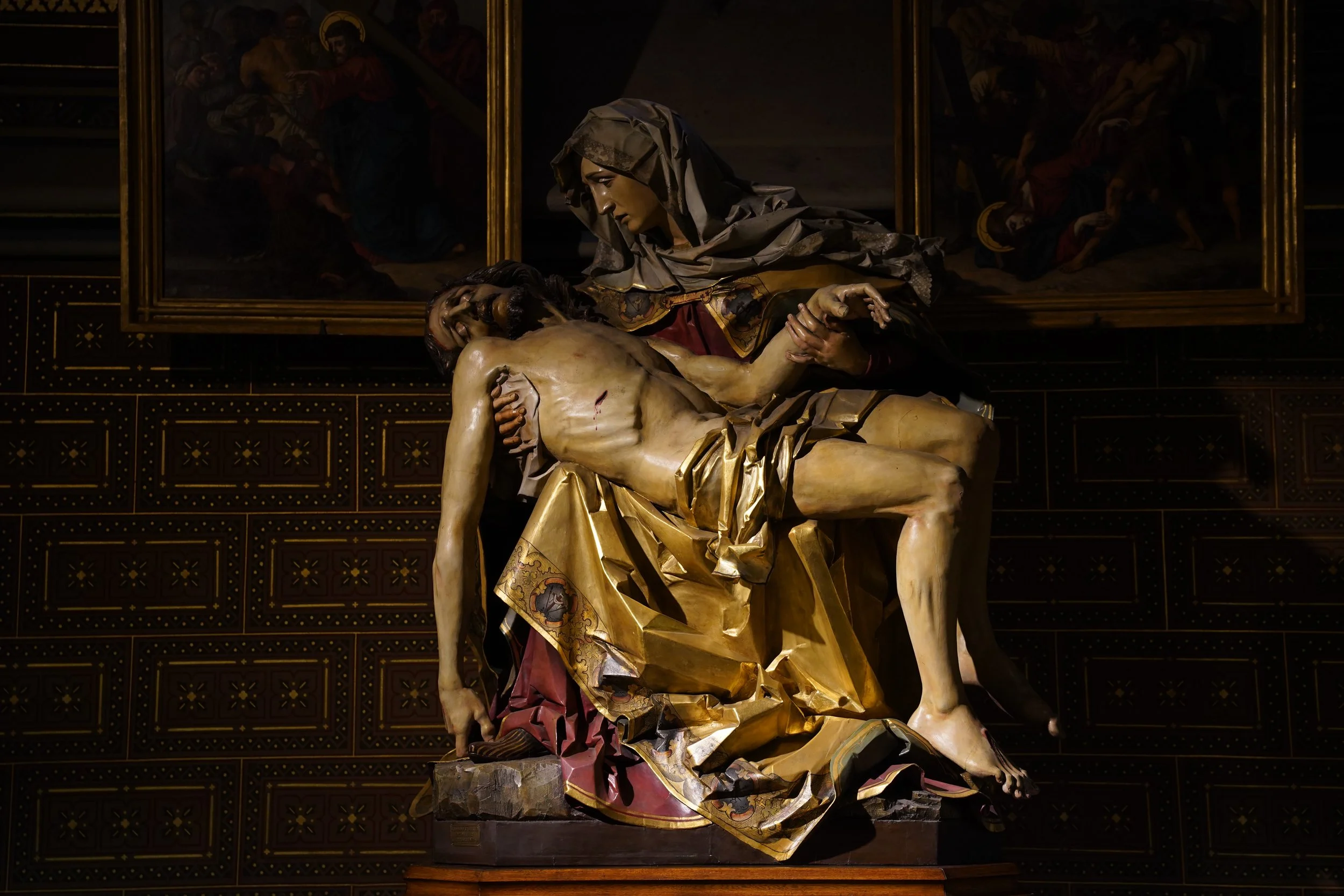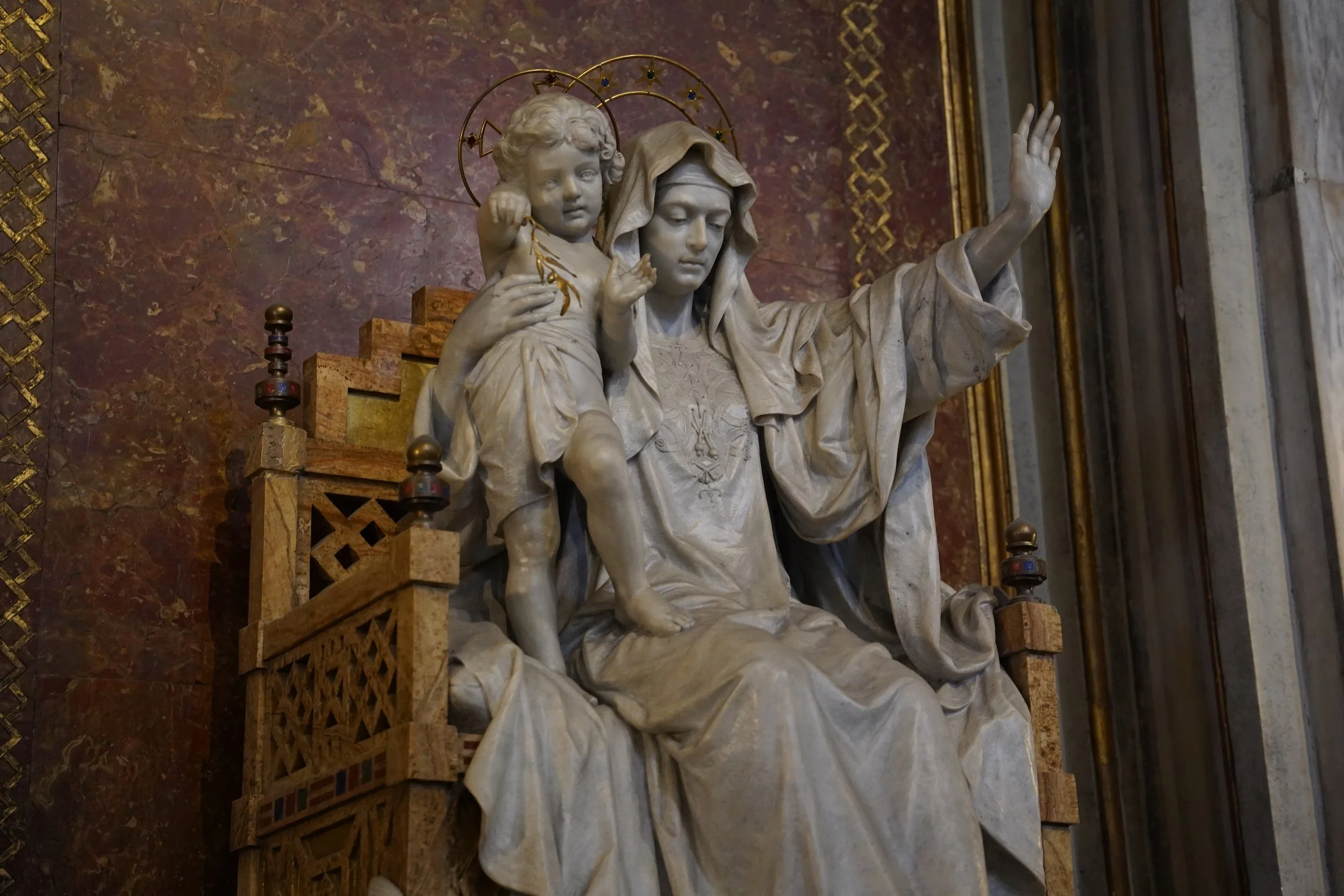The Challenge of Sacred Art
Sculpture: Pietà, Ferdinand Stuplesser (1898 - 98) in the Basilica of St. Peter and St. Paul, Prague, Czech Republic. (Photo by Totus Tuus Apostolate)
Some time ago I was offered a full sized reproduction of Michelangelo’s Pieta. The company promoting it promised that it was truly made from marble and was an accurate cast from the original which is housed in St. Peter’s in the Vatican. A local artist informed me that the “real marble” was, in fact, marble dust that was bound with resins and poured into the mold.
There is nothing wrong with such a copy per se but it raises interesting and vital questions about the role and function of sacred art.
In an age of instant photography with smart phones, images created by artificial intelligence, and cheap reproductions of classic artworks, how should Catholic artists and pastors and people who are furnishing churches respond?
We should begin with primary questions. What is sacred art? What is it for? Is it important to the spiritual life? If so, why? If not, why not?
To answer these questions one needs a bit of background and context. In the sixth century the use of icons became more prevalent in the church. However, with the rise of Islam in the East, sacred images were increasingly considered to be violations of the commandment against making graven images. Eventually images were forbidden and existing imagery destroyed. This iconoclasm controversy—like most disagreements in church history—brought about by a resolution and clarity.
Through the theological insights of St. John Damascene and Theodore the Studite, Christian imagery was permitted. The argument was essentially simple: Under the old covenant before Christ’s incarnation, images were forbidden. However, referencing Colossians 1:15, Jesus Christ was the image (icon) of the unseen God. Therefore, images of Jesus Christ were not idols. They were reflections of the supreme image of God: his incarnate Son.
Furthermore, images of the theotokos — the Mother of God — were also legitimate as the Son of God took his human flesh from his mother. In a secondary way, images of saints were also permissible as they were (as divinized members of the Body of Christ) also sharers in the divine nature (2 Peter 1:4).
Sculpture: Statue of Our Lady, “Ave Regina Pacis,” which is situated on the left aisle of the St. Mary Major Basilica, Rome. (Photo by Totus Tuus Apostolate)
Thus began the venerable tradition of Christian iconography — in the east icons — two dimensional representations, and in the West eventually the development of full round sculptures. This being the case what particular challenges were faced by the sacred artist?
There remains the primary question of what sacred art is and what its function might be.
The first question is answered in John Damascene’s defense of iconography: sacred art is a secondary image of God's primary revelation in his son Jesus Christ. What is the image’s function? Through the senses it opens our hearts and minds to a deeper understanding and appreciation of God’s primary revelation the incarnate Son. To put it simply: when I behold an image of the Savior my mind is enlightened and my heart inspired to a deeper understanding and appreciation of Christ the Lord.
With that in mind, what is the primary challenge in depicting the Lord, Our Lady or a saint? It is for the artist to portray a real person while also capturing an ineffable saintly quality. How does one produce a portrait—let’s say of St. Therese of Lisieux (for whom we have photographs) while also portraying her saintliness?
If the artist errs too far in the direction of producing a realistic portrait he misses the difficult task of portraying her invisible holiness. Should he err too far in attempting to portray the spiritual essence, the result can be cloying, sentimentalised, or even somewhat spooky. We can all remember bad Catholic art in which Jesus looks effeminate, for example. In an attempt to portray the holiness of the Lord (who was a rugged Jewish man from the first century) the artist has given him blonde wavy hair, long eyelashes, pink cheeks and blue eyes.
On the other hand, attempting to show his human nature, other artists have chosen a hyper realistic and naturalistic portrayal and Jesus looks just like an ordinary Jewish carpenter with dirt under his fingernails. These same challenges exist whether the medium is a painting, a sculpture, or in our modern age — a filmic representation.
The successful sacred artist solves this problem, and the best sacred art succeeds in this solution even if we, as the viewer, are not aware of how the artist has solved the problem. In other words, we view the sacred art and it does what it is supposed to do: it opens our eyes and hearts to a deeper understanding and love of the subject.
Now with all this in mind, what should be our opinion about instant art—quick and inexpensive reproductions, artificially produced images and photography? If we are furnishing a church or chapel should we just obtain some prints of famous Catholic art to hang on the walls? Why not hang up a picture of Michelangelo’s Pieta or DaVinci’s Last Supper?
There is nothing intrinsically wrong with reproductions. There is a long history of copies being made of particular paintings and sculptures for devotional purposes. Indeed most of the statues that are available from religious goods catalogues are mass produced and therefore copies and not original designs.
The most important thing to consider in using reproductions of any kind is to use them sparingly and place them with careful thought so that they will fulfill their purpose of inspiring devotion and thought. Putting a cheap poster of DaVinci’s Last Supper on the wall with sticky tape, or plopping down a cheap plaster statue just anywhere doesn’t work. However, if a reproduction is carefully chosen, framed nicely and placed in a key devotional location along with some candles, flowers or a kneeler to give focus, it can fulfill its function.
Some devotional art in a church or chapel is, by its nature, conventional and traditional; and therefore reproductions and copies purchased from catalogues can be perfectly serviceable if they are of good quality and design. So, for example, stations of the cross or crucifixes are expected in churches and chapel, and a great variety of mass produced works are available. As such, most are worthwhile and do what they are intended to do as explained above.
Stone Crucifix, Vyšehrad Cemetery, Prague, Czech Republic. (Photo by Totus Tuus Apostolate)
If a special focus is needed it is better to commission a contemporary artist to produce a new work of art, but to do so requires careful thought and knowledgable consultants. One new work of art could be worth dozens of cheap reproductions if it is designed well and complements an overall plan for a church or chapel.
The artist needs to be schooled not only in traditional craftsmanship, but also needs to know and understand the tradition of sacred art. They must be able to exhibit a capability of working within the tradition while also refreshing the tradition with their own talent and creativity.
Along with this, one must encourage a new generation of patrons of the arts. New artwork must be paid for, but if it is well thought out and well executed it can be an inspiration for ages to come.
For examples of new Catholic art readers may wish to explore the website of Our Lady of the Rosary Catholic Church in Greenville, South Carolina, USA. Go here for a church tour.



